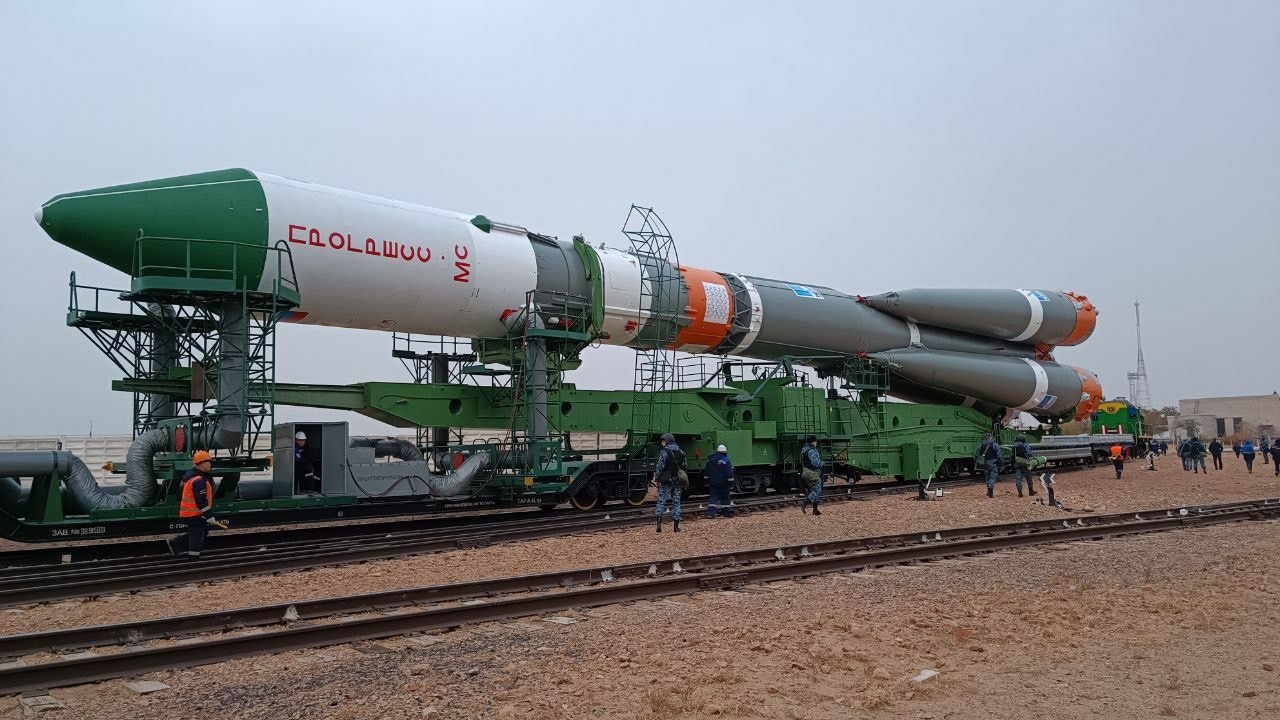
Russia is set to launch a Progress supply freighter Tuesday on a two-day trek to the International Space Station to deliver 5,556 pounds (2,520 kilograms) of cargo, fuel, water, and nitrogen to the orbiting research laboratory.
A Soyuz-2.1a booster will launch the Progress cargo ship at 8:20 p.m. EDT Tuesday (0020 GMT Wednesday) from the Baikonur Cosmodrome in Kazakhstan. The liquid-fueled rocket will deploy the Progress MS-21 spacecraft into orbit about nine minutes later, and the supply ship will unfurl solar panels and navigation antennas to begin the flight to the space station.
A series of orbit adjustment burns will put the Progress spacecraft on course for an automated, radar-guided docking at the station’s Poisk module at 10:49 p.m. EDT Thursday (0249 GMT Friday). Russian cosmonauts on the station will open hatches to begin unpacking cargo from the pressurized cabin of the Progress spacecraft.
Russia’s Progress MS-19 spacecraft, which delivered supplies and fuel to the station in February, undocked from the Poisk module Oct. 23 and fired thrusters for a final disposal burn to fall back into the atmosphere. Loaded with trash and other unnecessary equipment, the Progress MS-19 spacecraft largely burned up during re-entry, spreading bits of debris over a remote part of the Pacific Ocean.
The departure of the Progress MS-19 spacecraft clears the way for the arrival of the new Progress supply ship Thursday.
Meanwhile, Russian ground crews at Baikonur rolled the Soyuz rocket from its integration hangar to its launch pad Oct. 22. A hydraulic erector raised the rocket vertical at the Site 31 launch complex for final liftoff preparations, and gantry arms enclosed the Soyuz launcher to provide technicians with access to different parts of the vehicle.

Russian managers plan to meet a few hours before launch Tuesday to approve loading of kerosene and liquid oxygen propellants into the Soyuz rocket. The gantry arms at the launch pad will retract away from the rocket in the final hour of the countdown, and ground crews at Baikonur will insert the launch key into a control panel about six minutes before liftoff.
Propellant tanks on the launcher will be pressurized beginning about two-and-a-half minutes prior to liftoff, and engines on the core stage and strap-on boosters will ignite and ramp up to full power to propel the Soyuz off the pad with more than 900,000 pounds of thrust.
The Soyuz rocket will head northeast from Baikonur to line up with the flight path of the space station. The launcher’s four first stage boosters will jettison two minutes into the flight, followed moments later by jettison of the aerodynamic nose cone to reveal the Progress supply ship to the environment of space.
The Soyuz core stage, also known as the second stage, will shut down and separate nearly five minutes after launch. A third stage RD-0110 engine will ignite to finish the job of accelerating the Progress cargo freighter to orbital velocity, then will deploy the supply ship almost nine minutes into the mission.
The Progress MS-21 mission is known as Progress 82P in the space station’s schedule of visiting vehicles. It’s the 82nd Russian Progress resupply mission to launch to the International Space Station.

Russia’s space agency said the Progress MS-21 cargo ship will carry 1,548 pounds (702 kilograms) of hydrazine and nitrogen tetroxide propellants to replenish tanks on the space station’s Zvezda service module. The mission will also deliver 926 pounds (420 kilograms) of fresh water, 90 pounds (41 kilograms) of nitrogen gas, and 2,992 pounds (1,357 kilograms) of dry cargo.
The dry cargo includes food and clothing for the space station crew members, personal protective equipment, and medical, sanitary, and hygienic supplies, according to Roscosmos. The Progress MS-21 spacecraft is also packed with scientific equipment and spools of filament for a 3D printing experiment on the space station.
The Russian supply ship will also reboost the orbital altitude of the station, and perform any required burns to steer the complex out of the path of space junk.
Russia’s Progress MS-20 supply ship, which remains docked at the station, performed a debris avoidance maneuver Monday to move the outpost away from the predicted track of a fragment of debris from the Kosmos 1408 satellite, which the Russian military destroyed in an anti-satellite weapon test in 2021.
Email the author.
Follow Stephen Clark on Twitter: @StephenClark1.
from Spaceflight Now https://ift.tt/jsFTKnS
via World Space Info







0 comments:
Post a Comment